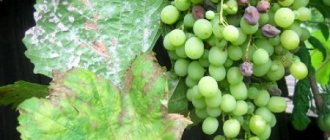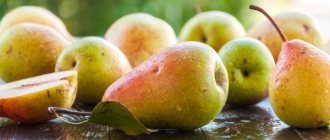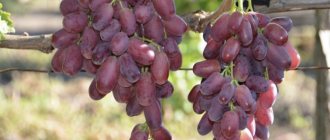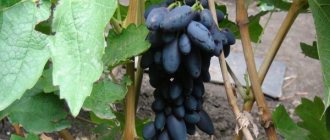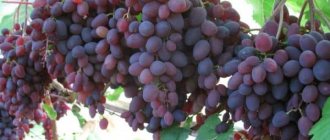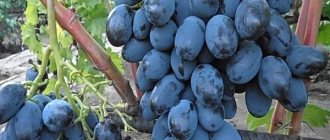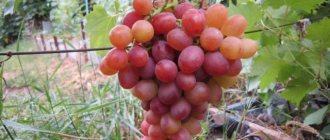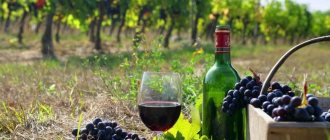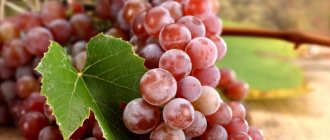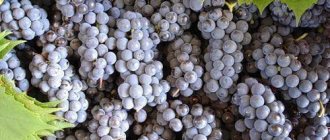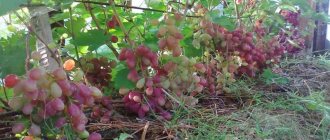Advantages and disadvantages
Like any other variety, “Tason” has its pros and cons.
Pros:
- Early ripening of berries
- Bright nutmeg taste.
- Doesn't pea.
- High yield.
- The grapes ripen evenly.
- Attractive presentation.
- Frost resistance.
- Good transportability.
Minuses:
- Not resistant to fungal diseases.
- The vine may be overloaded with harvest.
- Damaged by wasps and birds.
- Depending on weather conditions, the berries may color unevenly.
- Requires shelter for the winter.
Where
This popular variety was bred by workers of the All-Russian Research Institute of Viticulture and Winemaking Y.I. Potapenko (VNIIViV) through long and labor-intensive breeding work. Tason is an artificially bred hybrid variety. In order to get a new variety, professional breeders crossed Italy grapes with Zoreva. The Tason grape variety quickly gained its popularity, as there is something to love about the variety. Like all other grapes, this variety loves the sun, warm weather, and the south. It can also grow in more northern regions, for example, in the Moscow region. But in order for this to happen, you need to spend much more time and effort caring for this variety. We will look at the description of the variety in more detail below.
Main characteristics
In terms of the totality of its qualities, Tason has no equal among Muscat grape varieties.
Ripening period
According to the ripening period, the hybrid belongs to varieties with a very early ripening period. From the growing season to harvest, about 100-110 days pass.
Reference! The ripening period does not depend on weather conditions. Gardeners not only in the southern regions, but also residents of the Moscow region and Leningrad region note that grapes ripen as early as the 20th of July. If you do not pick the berries right away and let them hang on the bushes for a while, they will become sweeter and acquire a richer nutmeg flavor.
Bush
“Tason” bushes are vigorous. They have a strong root system and powerful vines. The leaves are dark green, consist of five lobes and are strongly dissected. Thanks to the bisexual flowers, grapes do not need additional pollination.
When grown in the cool climate of the middle zone, it is recommended to form the “tason” as a covering grape. The most suitable for it are fan and semi-fan multi-sleeve molds. You can form a bush in the form of a two-armed cordon.
In warm regions where winter shelter is not required, this tall hybrid can be grown on an arch or with a high trunk.
Bunches and berries
The bunches of the “tason” are cylindrical-conical in shape with an average density of berries. The brushes are quite large, weighing 500-800 grams, sometimes ripening specimens weighing 1.2 kg. Thanks to the massive clusters and unusual color of the berries, the bushes look very bright and attractive.
Translucent “tasona” berries are white and pink. In the sun's rays, the grapes acquire a tan, but in the shade they do not color and remain white. The fruits are quite large, up to 25 mm long and up to 18 mm wide.
When exposed to light, under the thick skin, elastic flesh of a golden amber color is visible. The pulp contains from 3 to 5 small seeds, which are practically not felt when eaten. Sugar content of berries is 19-21%, acidity is 5-6 g/l.
Taste
Thanks to its noticeable nutmeg taste and early appearance on sale, “tason” is quickly sold out in the markets. It earned a tasting score of 8.2 points and is considered one of the most delicious varieties of early ripening grapes.
Despite the fact that the skin is quite dense, it is practically not felt when eaten. Under the skin lies a fleshy and crispy amber flesh. The taste of the berries is sweet, harmonious, nutmeg. Some connoisseurs noticed strawberry notes and honey aroma in the taste.
Productivity
The vine bears good fruit and ripens almost completely. Two clusters ripen on one shoot; sometimes an adult grape bush can produce a harvest of up to 40 bunches. The total weight of the collected fruits averages 20-35 kg.
Diseases. Infections. Pests. Treatment methods
There is an opinion that Tason grapes are highly susceptible to various diseases and fungal infections. But those who grow these grapes note that with good and proper care, the risk of disease is greatly reduced. Many winegrowers have been growing this variety for years and have never been infected.
But still, diseases such as:
- Powdery mildew or as it is also called white. This is a fungal infection that causes a white coating on the leaves and gradually kills the entire plant if left unchecked. If this disease is not detected in time, then you can say goodbye to the harvest and the plant itself forever. In order to fight this disease, grapes need to be sprayed with chemicals that contain vitriol, folpet, karbofos, captan, etc.
- Another uninvited guest may be phylloxera. The causative agent of this disease is a microscopic aphid, which mainly affects the leaves. It sucks out all the beneficial substances, thereby killing the plant. Inflammations similar to blisters appear on the foliage. If aphids have settled on your grapes, they should be destroyed immediately using chemicals that can be purchased at any specialty store.
Tason grapes have a risk of contracting diseases, but if you carry out prevention by spraying the grapes with chemicals, you can protect them from illness. Spraying is best done before the grapes bloom and after the last ripe bunches have been removed from the bush.
Other pests that can lay claim to your crop are various small birds and wasps. But fighting them will not take much time, nerves and great effort. In order to protect your harvest from birds that love to peck berries, you need to place your grapes in a kind of “cage” made of mesh. The main thing to remember is that the net is not made of rope, and not a very fine mesh, otherwise the birds may get entangled there and die.
Wasps are just as easy to deal with. In general, wasps are quite useful insects on your site; they destroy such types of pests as aphids. Aphids not only love to attack grapes, but also other horticultural crops. But besides this, wasps also love to eat ripening grapes, especially such a sweet variety as Tason. In order for your berries not to lose their marketable appearance, and for you to be able to harvest a good, large harvest by the end of summer, you will need to protect the grape bunches from these insects. This can be done using very fine mesh fabric bags to act as a barrier for wasps.
The Tason grape variety is, of course, loved by many people who grow grapes, as well as those who simply like to eat them. If you follow all the necessary care rules, you will not have any problems. Tason is a very good, tasty variety, which since its appearance has been very fond of many grape lovers who know a lot about it.
Comparison with analogues
How you want to taste ripe juicy grapes on a hot summer day! It is especially pleasant when it is grown on your own plot. To taste the fruits of the new harvest as early as possible, plant early-ripening grape varieties that will delight you with sunny berries by the end of July.
“Tason” undoubtedly occupies a leading position among very early varieties.
| Sign | Variety | |||
| Tason | Libya | Laura | Transfiguration | |
| Ripening period | 100-110 days | 105-110 days | 110-115 days | 110-115 days |
| Frost resistance | up to -22°С | up to -21°С | up to -25°С | up to -21°С |
| Yield per bush | up to 35 kg | up to 30 kg | up to 20 kg | up to 20 kg |
| Bunches | 0.5-0.8 kg | 0.8-1.2 kg | 1 kg | 0.7-1.5 kg |
| Taste | bright nutmeg | nutmeg aroma | light nutmeg | harmonious, dessert |
| Color | pink-white | pink | pale green | light pink |
| Disease resistance | low | average | average | average |
| Shelf life | up to 3 months | up to 1 month | up to 2 months | up to 6 months |
| Sugar content | 19-21% | 18-23% | 20% | 17-19% |
| Acidity | 5-6 g/l | 6-7 g/l | 6-8 g/l | 6-7 g/l |
Methods of propagation of grapes
The Tason variety is propagated in all possible ways: cuttings, grafting, cuttings, seedlings. It cannot be propagated only by seed.
Most often, grapes are propagated by grafting. The vaccination procedure is as follows:
- the selected rootstock bush is completely cut off so that only a small stump remains;
- the stalk is cut in the form of a wedge and placed in the split of the stump;
- the graft is tightly wrapped and lubricated with clay.
The vaccination process is shown in the video:
Useful properties and scope of use
Grapes contain a huge amount of microelements beneficial for the human body. These include vitamins, minerals, and fruit acids. Grapes have a positive effect on the functioning of the gastrointestinal tract and cardiac activity, it strengthens the immune system and improves mental activity.
Important! Due to the fairly high sugar and acidity content, grapes should be consumed with caution by people suffering from diabetes and those with high stomach acidity. The rather high calorie content does not make this product dietary. If consumed in large quantities, it may contribute to weight gain.
Many people like the table grape variety “Tason” fresh. However, due to the brightness of Muscat, most of its fruit is used to make elite wines. Amateur winegrowers can preserve the harvest by making preparations for the winter: juices, jams, compotes, raisins. Winemakers can please loved ones and guests with excellent homemade wine.
What type does it belong to?
Tason is a table hybrid subspecies of pink grapes. Pink varieties also include Angelica, Gurzuf pink and Flamingo.
Ripening period is super early. The berries ripen by the end of July - the first days of August.
The variety is very popular because of its hardiness and excellent commercial qualities - the berries do not crack, do not rot, and withstand storage and transportation well.
It is in high demand among buyers both in the form of berries and seedlings. We love it very much in its natural form - because of its unobtrusively sweet, aromatic taste with a rich aftertaste with notes of rose, honey, nutmeg and strawberry. It is also used in bouquets of elite table and dessert wines.
The varieties Descendant Rizamata, Helios and Zarya Nesvetaya are also often used in blending.
This is interesting: How to plant and care for turnips in the country - our point of view on the question
Features of cultivation
Tason grapes are excellent for cultivation in areas with short and cool summers. Thanks to its rapid ripening and unpretentiousness, gardeners receive abundant harvests by the end of July.
Landing
When purchasing seedlings, pay attention to their quality. The cuttings should not show signs of disease or damage. The roots of the plant must be intact and strong.
“Tason” can be planted both in spring and autumn. Experienced winegrowers recommend preparing the planting site in advance. So, when planting in spring, the soil is prepared in the fall. If this is not possible, then it is recommended to prepare at least 2 weeks in advance.
Landing rules:
- Dig a hole 80 cm deep and wide.
- The bushes are planted at a distance of 1.5 m from each other, and there should be 3 m between the rows.
- If groundwater is close, it is worth pouring drainage: expanded clay, crushed stone or brick chips.
- A mixture of chernozem and fertilizers containing potassium and phosphorus is poured into the bottom of the hole.
- A layer of black soil is poured on top and left in this form for some time so that the fertilizers are absorbed into the soil.
- Now you can place the seedling in the hole, straighten its roots and add soil.
- The soil around the plant is lightly compacted and watered abundantly - about 20 liters per bush.
To prevent moisture from evaporating too much, the soil around the bush is mulched using sawdust, humus, straw, spruce branches, spunbond and other materials.
Place and soil
“Tason,” like all grape varieties, loves warmth and sunlight. Therefore, when growing in a cool climate, it is worth choosing the southern part of the site, which is well lit by the sun most of the day. If there is a lack of light, the berries of this hybrid will not turn pink and will remain white. More details about the ideal place for grapes in a separate article.
This grape loves light, loose soil. It is undemanding to the composition of the soil and can show excellent results even on infertile lands.
Watering and fertilizing
The first time after planting, watering must be carried out daily. Provided that the weather is fairly dry and there is no rain.
Reference! It is better to water the grapes in the evening so that the sun's rays do not burn the plants. The water should be settled and warm.
During the season there are 4 main irrigations:
- After flowering.
- During the formation of berries.
- After the harvest.
- Before sheltering for the winter.
If the season turns out to be dry, then the amount of watering is increased.
Mature grapes need regular feeding. Organic fertilizers are applied after flowering, during the formation of berries. Before sheltering for the winter, the bushes are fertilized with preparations containing potassium. And also during the season, foliar feeding is carried out by spraying with solutions of nitrogen, potassium and phosphorus fertilizers. Spraying is often combined with treatment against diseases and pests.
Trimming
Pruning of the “shade” is carried out both to form the required shape of the bush and to lighten it. If the vine is very dense, it does not transmit sunlight well, ventilation is impaired and the plant becomes vulnerable to diseases.
In the spring, you need to remove shoots damaged during the winter and frozen out. In the summer, green pruning is carried out to regulate the density of the bush. In this case, all unnecessary shoots and stepsons are removed.
The main pruning is carried out in the fall, after the leaves have completely fallen. “Tason” can withstand a heavy load, however, the number of vines must be normalized so as not to overload the bush. 30-40 shoots and 10-12 eyes are left on each plant.
Reference! It will take 3-4 years for the vine to form into a fan.
Diseases and pests
“Tason” has low resistance to fungal diseases. However, with proper cultivation techniques and regular preventive measures, damage to the vineyard can be avoided.
To protect plants from fungal infections, preventive spraying is carried out with fungicides, such as: Quadris, Topaz, Horus. Treatment can be combined with watering.
Birds, which are not averse to eating juicy sweet berries, can cause great damage to the crop. As practice shows, installing various repellers gives a short-term effect. The most successful protection is to put a fine-mesh synthetic net on the bushes or separately on each bunch.
Wasps can also cause considerable harm. To get rid of insects, containers with a mixture of sweet syrup and insecticides are placed near the vineyard.
Shelter for the winter
This hybrid has good frost resistance and can withstand temperatures down to -22°C. Thanks to this, the southern plant is successfully grown in temperate climates. However, in the conditions of the Central region and Siberia, these grapes should be covered for the winter, because Winter temperatures in these areas usually fall below the maximum permissible level.
Sheltering is done in the fall, when the leaves have fallen. First, the grape bushes are pruned and fertilized to increase immunity. Next, the vine is removed from the trellis, tied and laid on the ground. You can pre-mulch the soil under the vine. Any materials available to you are suitable for shelter: earth, straw, spruce branches, agrofibre, boards, etc.
Harvest storage
The “tasona” harvest can remain on the vine without losing its qualities for up to 2 months. The fruits, ripe at the end of July, hang well until autumn, acquiring an even more pronounced nutmeg flavor.
The cut bunches are stored in the basement or refrigerator for up to 1 month. The longest grapes can be stored are suspended in individual clusters, in a dry and cool basement. In such conditions, the freshness of the berries can be preserved for 2-3 months.
How to care for the Tason variety
Proper care can improve the quantity and quality of the harvest several times.
Watering and fertilizing
Tason loves a lot of water, so the shrub requires regular watering with soft, warm water. Irrigation is carried out in the early morning or evening, when the soil dries out. Stagnation of moisture can lead to rotting of the roots and watery berries.
Fertilizing is carried out with mineral and organic fertilizers, alternating them.
For your information! Nitrogen (urea or saltpeter) is introduced during the period of formation and growth of green mass; phosphorus (superphosphate) is added at the beginning of the flowering period; potassium chloride and wood ash help speed up the ripening of fruits and strengthen the plant before wintering; copper is needed to increase drought and frost resistance; zinc is necessary to increase the number of berries.
Bush formation and pruning
Pruning is necessary to speed up the ripening of berries, improve their taste, and increase yield. The procedure also improves the appearance of the shrub and simplifies its care. Those shoots that block sunlight for the grapes are pruned. You can leave up to 40 eyes on one bush (up to 8 pcs. on one branch).
Cultivation regions
The Tason grapes were selected for cultivation in southern conditions. But thanks to its taste and high yields, it was expected that gardeners in the Central region began to cultivate it. Thanks to its good frost resistance, this hybrid is successfully grown not only on the lands of the Crimea and the Krasnodar Territory. Gardeners in the Moscow region and even the Leningrad region note excellent yields and taste, indistinguishable from the southern “tasson”.
Reviews
The taste is simply amazing, number 1 on my list. Alexander, Kyiv
One drawback is the covering. This year the first harvest is 6 kg (in the past - the signal brush on the 2nd year was not so impressive), the largest brush is 850g, the color and taste are incomparable! Gennady, Ochakov
The variety is a pleasure! Good in every way! It overwintered well, with standard treatments it shows good resistance, it ripens very early, the vine ripens perfectly, a beautiful bunch is around 500g (for now), nothing had to be rationed - everything in moderation: one or two bunches per shoot, the most beautiful harmonious muscat - one of the best tastes on my site. Hangs on the bush for a long time - the taste does not deteriorate. Tatiana, Belgorod
Further care
At the initial stage of cultivation, special care for plants is not necessary. Watering is done extremely rarely; during the entire grape growing season, the number of waterings does not exceed 3-4 times. During flowering and fruiting, the crop cannot be watered so as not to spoil the future harvest. In addition to watering, the condition of the leaves and vines of the grapes is monitored daily. At the slightest change you should be wary. The appearance of a white coating, holes on the leaves, and spots signals danger. These changes are the first signs of disease, so treatment is not delayed.
To prevent grapes from getting sick, you need to treat the crop with antifungal drugs such as Fundazol, Hom, Folpan, Flint, and Switch. Before using additives, carefully read the instructions, and further dilution and use are carried out in full accordance with them. For prevention, 2 consecutive treatments are usually carried out with an interval of 5-7 days.

